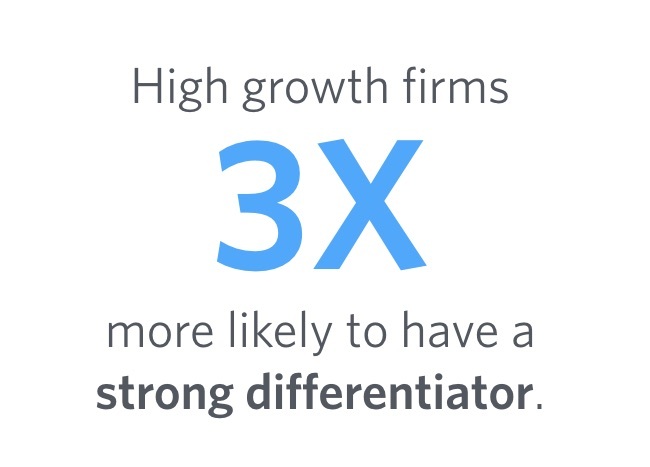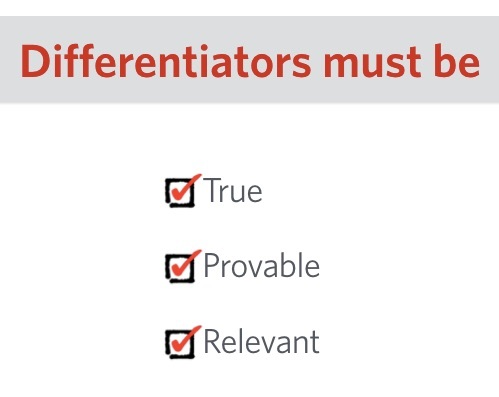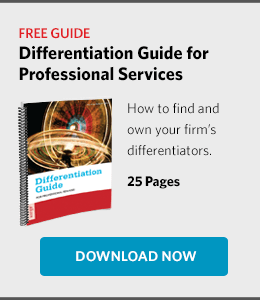The undifferentiated professional services firm—there are a lot of you out there.
It happens innocently enough. Firms grow early on as they grab business by being all things to all people. As easy as that initial undifferentiated climb can be, executing a sustained growth strategy when you aren’t differentiated can be near impossible.
Differentiation is one of the most poorly understood pillars of professional services marketing. Many execs still believe differentiation isn’t a necessary component of overall growth. Reality is, it matters. In fact, it matters a lot.
In our research on high-growth, high-value professional services firms, we found that high-growth firms are almost three times more likely to have a strong differentiator.

Differentiators make it easy for decision makers to understand why they should choose you. And differentiators make it easy for referrals to explain why others should choose you, too. So, the foundation of any growth strategy for an undifferentiated firm must be to uncover your differentiators.
What is a differentiator?
Put simply, a differentiator is something that makes your firm meaningfully different from other firms. Yours doesn’t have to be the only firm with that characteristic. You just want to set yourself apart from the competition.
Say, for example, you specialize in working with manufacturing companies. Others in your industry may share that specialty. But as long as most do not, you have a differentiator.
A good differentiator makes it easy for a prospective client to decide you’re the one. For that reason, differentiators are at the heart of any solid growth strategy.
What a differentiator is not
To meaningfully set yourself apart from the competition, your differentiators have to be true (of course), relevant to your target audience, and supportable.

With that in mind, statements like “We care about our clients,” or “We do quality work,” or even “We have great people,” are not differentiators at all. They may be true, they may even be relevant to your audience. But almost every firm will stake a claim around good people and good work.
Unfortunately, these “soft” characteristics are often the very attributes that firms believe sets them apart. But with so many others saying the same thing, it’s hard to support how you might actually be different in this regard.
Building a growth strategy around differentiation
So how can you uncover your own set of differentiators? Here are five principle steps that will help you find a real differentiator for your firm—and not just find it, but own it. Then develop it into a solid and sustained growth strategy.
1. Choose an approach to differentiation. There are two basic approaches to identifying your differentiators. You’ll need to understand and weigh your options before you proceed. At the highest level, the two approaches are:
- Making conscious management decisions that differentiate your firm from the competition. Put another way, you can make deliberate decisions around how you will be different.
- Discovering the existing characteristics that distinguish your firm. This is a process of uncovering—or discovering—differences, but not creating them.
Both approaches are legitimate and can be effective. Of course, the first approach is more proactive. It requires a boldness and improvisation and could mean making significant changes to the nature and direction of your business.
The second approach is a bit more passive, relatively speaking. But it can yield tremendous benefits to firms that aren’t situated or seeking to make dramatic changes in direction.
Interestingly, you can explore both paths in parallel, because the way forward for both approaches is the same: research.
SEE ALSO: Why Brand Differentiation is Essential for Professional Services Firms to Succeed
2. Assess possible differentiators through research. Many firms fall into the trap of sitting their best and brightest around a boardroom table and tasking them with coming up with a list of differentiators. It doesn’t work. Time and again, we’ve seen that firms misperceive their audiences’ key challenges, their own relevance to client needs, and even who their competitors are.
Research allows you to uncover the way your clients, prospects, or even influencers define the problem, talk about their needs, see your competition, or even perceive you. Research empowers you to base decisions about your differentiators on facts rather than hunches.
If you’re exploring conscious changes in direction, research may help you specialize based on what you learn about your success with particular clients. Perhaps research uncovers that you’ve had particular success with family-owned businesses, for example. This finding may be an avenue for specialization, and that specialty could make for an effective differentiator.
Similarly, you could research several business categories and find one that seems to afford the most opportunity. You may discover emerging issues, business models, or unmet needs that you’re particularly well-suited to address. Research helps you objectively evaluate these opportunities for differentiation.
On the other hand, if you are leaning towards discovering your differentiators, you’ll want to focus marketplace research on your clients, influencers, and prospects to understand how they perceive your firm. Is there anything you do that strikes these audiences as different, unique, or valuable? Is there anything you’re considering that stands out as being worthwhile?
Your clients and prospective clients may even identify an aspect of your firm that you haven’t recognized, simply because it’s business as usual for you. For example, they may help you realize that you’ve configured your services in a way that other people haven’t, but that difference isn’t obvious to you. For example, you may be offering workshops in an industry that typically doesn’t.
Taking advantage of external perspectives will help you see yourself as the marketplace sees you, which can be invaluable.
3. Identify the differentiators you want to pursue. Once you’ve explored potential differentiators through research, it’s time to choose the ones that you will focus on to define your firm in the marketplace. You’ll want to aim for 3–5 differentiators. Any more than that, and you’re likely to be in the realm of general rather than distinguishing characteristics.
To be sure, there are two sides to every differentiator: a downside as well as an upside. Firms understandably worry that, once they decide on a few differentiators, they do so at the expense of all revenue that might come from being a jack of all trades.
For example, if you decide to focus on serving small firms, you may be discounting opportunities with larger firms. But that focus could be the right direction for you. Remember that specialization drives business growth faster than generalization.
The best strategy is to consider the intersection of the kind of firm you want to be and the genuine opportunity to solve the real problems of your target audience. Then select your differentiators accordingly.
4. Validate with the marketplace. Once you’ve identified your differentiators—either the existing qualities you will emphasize or those that you’re setting out to claim—it’s time to validate them with the marketplace.
Validation may come in the form of secondary research to ensure you can back up every claim effectively. Evaluate your proposed differentiators. Investigate whether competitors are taking a similar tack, and to make certain what you’ve identified is true, relevant, and supportable.
5. Support your differentiators. After validating your differentiators, it’s time to live them out, proving and re-proving them every day. Of course, some differentiators are easier to prove than others. If you say, “our specialty is working exclusively with female entrepreneurs,” audiences will know pretty quickly whether or not you can back that up.
Other differentiating claims, like “Our customer service is demonstrably better than the competition,” might require more work to support. For these broader differentiators, you’ll need more than testimonials—you might need a thorough study. Something going much deeper than an assertion.
You will also need to back each differentiator up with policies and training to make it real and lasting.
And your differentiators must be communicated. If no one knows it, it’s not a differentiator. Ensure your website and marketing materials describe, reflect and prove your differentiators. Likewise, make sure that everyone, from senior leadership to business development to human resources to marketing communicates, speaks in a way that reinforces your differentiators.
The Bottom Line on Differentiators
An effective differentiator is a lot more than a lofty idea. It is your firm’s very DNA. When a differentiator is working as it should, it’s a guiding imperative, expressing itself in your firm’s every action.
You have to live your differentiators every day, working and acting in ways that are consistent with them. The work is continuous, and if you do it well, it can move you to new levels of success, and growth.
Additional Resources
- Our free Differentiation Guide for Professional Services Firms guides you through how to build a powerful differentiation strategy.
- Download a free copy of the book Inside the Buyer's Brain to learn how to build a well-differentiated brand to help your firm close more sales.
- In this post, learn Why Brand Differentiation is Essential for Professional Services Firms to Succeed.
How Hinge Can Help
Identify competitive differentiators that will help your firm stand out from the competition and build a brand that drives sustained growth with Hinge's Branding Program.



